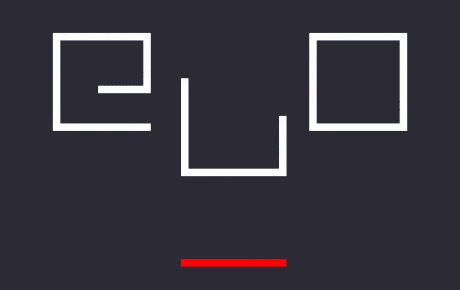Les Mots et les Images is a work by J.-M Dutey published in alire 5 in 1991. At first, one encounters a table that is divided in 21 smaller boxes. Here, there is a spatial idea that is introduced which Dutey wished to explore as seen in a quote from the work itself, “(Dutey) voudrait que sa poésie explore les espaces qu’elle occupe et ceux qu’elle suggère.” This quote expresses an exploratory desire because one has to click on the words on the screen to begin the program. If one chooses not to click, then nothing will happen. It is up to the user to explore the work, whether that is limited or full exploration. This seems to give the user a sense of control, yet when one chooses to begin; the control is replaced by a feeling of being lost in the connections between the words in the smaller boxes. The words that appear in the small boxes are the following: Magritte, tableau/forme, « pour alire n.5 octobre 1991, proposition, mot(s), représentation, image(s), nom, objet(s), autre nom, contours, signification, réalité, figures/précises/choses, figures/vagues/choses, Philippe Bootz/Jean-Marie Dutey, ou bien le contraire, et 1928.The box « Magritte » is named in reference to the Belgian painter, René Magritte. All of the images that are used in the program are images that Magritte created in his work “Les Mots et les Choses” which explores the relationship between things and words from 1929 during the surrealist movement. Next to the large table containing the 21 smaller boxes, there is a small table with the words “autres objets”. In that same corner, a third table is divided in 9 boxes with the word “clic”. When one clicks on one of the 18 words on the larger table, lines appear between the chosen word and other words on the screen. There is a variety of connections that are made, ranging from as low as 2 or 3 and going as high as 6 or 7. The lines that appear are all in different colors (red, green, blue, brown, yellow, pink, etc.) Sometimes, the connections between the words are not actually lines, but instead circles. After having clicked, one can click on the square at the corner. In relation to the number of connections in the larger table, the smaller table divided in 9 will show different colors correlating to the colors of the lines/circles. When the colors appear, one can click on a color which will proceed to a screen that shows the relationship between the original word chosen and one of the original images by Magritte. For example, when one clicks on “objet(s)”, there are 9 additional words that are connected to it, therefore there are 9 total colors on the table. When one choses one of these 9 colors, one sees the connection between “objet(s)” and the word to which the color links it to. In this case, red leads to “representation”. The screen that follows is the relation between an object and the idea of a representation. The screen shows two identical houses. The first house has “l’objet reel” written under it; the second house has “l’objet représenté”. At the top of the screen, there is a sentence: “tout tend à faire penser qu’il y a peu de relation entre un objet et ce qui le représente » (everything tends to lead to thinking that there is little relation between an object and that which it represents). All the relationships between the words are represented by images. All the images describe the idea of space, of representation, of vagueness and of interpretation.
Les Mots et les Images
Source Database:
ELMCIP
Source Entry URL:
Source Entry OAI-PMH Identifier:
oai:elmcip.net:9746
Source Entry Language(s):
English
Description(s):







